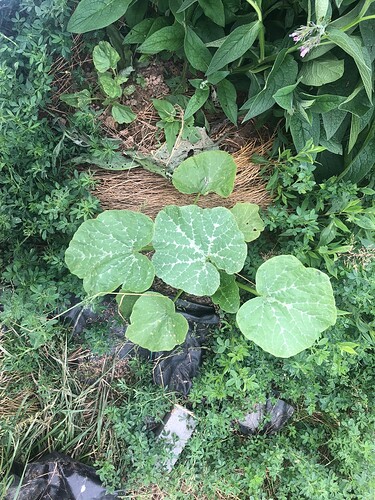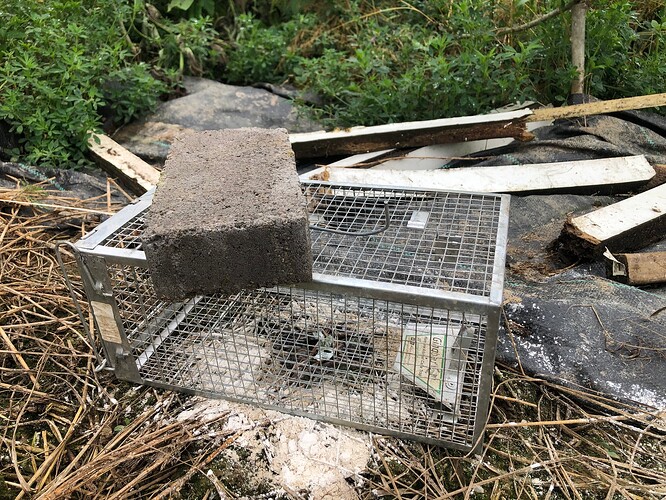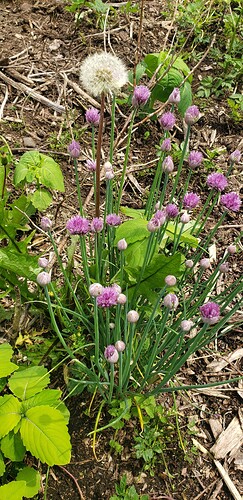Yikes! Pictures? Any stem stumps left?
Put eggshells and DE around whatever is left. See if they still disappear. If they do, it’s not snails or slugs but might be birds or pillbugs.
Thanks for that idea, Lauren, I will do the DE trick. I was planning to put some cages made of hardware cloth around some of them as well to see if that narrow down the list of culprits.
But yeah, mind-boggling, the watermelon and muskmelon landraced seedlings I have been growing for 3+ years are disappearing whereas the Maxima/Moschata/Pepo first year seedlings are growing like gangbusters, as if I have been landracing them for 3+ years.
I’ll figure it out and whatever is causing it better be ready for what’s coming to them…
Maarten
No stem stumps left, just a bunch of dust where all my hopes and dreams used to be ![]()
Maarten
My guess would be pillbugs. Birds would either snip it off or pull the plant. Only pill bugs will eat the whole plant, including the root, without showing any disturbance of the soil.
If it’s pillbugs, the difference between the two groups might not be the type of plant, but where they are planted.
I think you are correct, or at least some sort of bug. I have been adding manure to the garden which is a breeding ground for these “only eat dead matter” pillbugs.
I considered this as well, but I have planted moschata in conditions a,b,c,d and muskmelons/watermelon in conditions a,b,c,d, and only muskmelons/watermelons are wiped out. If conditions/location were the cause, I would have expected decimations of moschata as well.
So, either:
- muskmelons/watermelons are distressed and communicate that to the pillbugs, which attracts them and wipes them out
- moschata and others are germinating so plentiful or fast, that pillbug damage still leaves plenty of seedlings
- pillbugs don’t like moschata, they’d rather eat manure, but they love muskmelons/watermelons/beans
For instance, this is a row, beans planted at certain intervals, squash planted in groups. Where the beans are by themselves:
But when beans are surrounded by squash:
And this isn’t a one-off, it is the same through-out the row, beans surrounded by a group of squash have barely any damage, the solo beans are decimated.
Today I planted some Moschata in a circle, with muskmelons/watermelons in the middle, hope that works.
Thanks for the feedback, @Lauren , helped me think through it all
Maarten
I had voles eat watermelon seedlings last year and some other seedlings in previous years. Question seems to be access. Watermelons were eaten all in the last row where plastic mulch was connected to strip of grass/weeds between plots. So it was easy for them to access those seedslings in cover. Same was with brassicas one year. They were covered with plastic mulch. I can’t remember how that was connected to areas where voles like to move, but at least the years after without ground cover there has not been damage. This year I try to bury sides that connect to grassy area so that there isn’t easy safe access in the early season.
Yes, pillbugs they do eat the sprouted plants. Your explanation is spot on. But once the plants grow up to just starting to vine out they shoukd be ok?
Should be. Depends on how hungry the pillbugs are. I’d start putting out traps for them, a piece of fruit on the ground or a piece of cardboard with food garbage under it. Lift and discard the clump of pillbugs that clusters around your trap during the night. Reduce the population, they may return to their normal foods.
Apologies to hijack this WM thread which is now turned into a pest control thread, but hopefully some other people get some value from this discussion as well.
This is my dry garden, 30 min away from my home, which I only visit 1-2 times a week, so not as easy to do. So for now I just will be: 1) sow future watermelons/musk melons surrounded by an army of moschata seedlings 2) use a cage on some current seedlings to exclude the bird/vole angle 3) spray some current seedlings with surround 4) put DE around some current seedlings 5) both spray surround and put DE around some current seedlings.
A twist in a unique location of my yard: In my garden, most of the manure was dug under, with the soil put back on top. In this unique instance, I just put the manure on top of the soil and covered it with soil from another hole I dug, so more of a manure mound. Since the area was a little bigger, I put in both musk melons and moschata. Musk melons did awesome, no seedlings disappearing, I even had to trim them to 3 plants. But was it the comfrey hiding the seedlings from the voles/birds, comfrey isn’t close to the other spots? Is the manure being above ground making it better draining/warmer spot so a less inviting environment to whatever bug(pillbug?) is eating the seedlings in the other locations? Is the moschata’s exudates attracting some bugs that attract the pillbugs away from the musk melons?
(the musk melon is closest to the comfrey, as you can see, there is some insect damage, but that is recent, no insect damage during the seedling stage)
Maarten
Thank you for sharing, its all related to growing, no worries ![]()
![]()
Or, in my case, lack of growing, lol. But, back somewhat to topic, this is my watermelon seedling, encased in a rodent trap (with a piece cut out so the seedling fits in), surrounded by so much Diatomaceous Earth that it makes Colombia blush and sprayed with surround:
Maarten
Good ingenuity and protection. Do you have more spots you can sow seeds? What other veggies do you grow? Do you have flower and herb seeds to plant around too? I would plant a variety of herbs and other veggies all around too…try to hide that melon seedling with edible greenery.
..im at My Moms farm this week, foraging for good herbs to make tea, and harvest chives. Does yarrow grow where you are in Kentucky? Or basil? I forgot what you had mentioned about herbs.
We weren’t planning a watermelon grex, however… I planted the last of an old packet of Blacktail Mountain, our pen-pal garden club sent us a packet of seeds they had saved, someone else came up with a half-dozen varieties of heirloom watermelons, and the next thing you know, the second graders had seeded 72 watermelons. Fortunately, we have a couple places with room for multiple watermelon vines.
The last couple of years, the critters (including a rat that dug up an entire bed twice, an army of pillbugs, etc.) decimated the melons on campus. We’ve gotten everything to the 4 leaf stage this year with just a few casualties, so its looking promising.
The kids will be thrilled to see the melons grow! Almost as much as we are too.
Yes, Plenty of spots where I am planting seeds. Annual herbs and annual flowers are lower priority at the moment, those things seem to die no matter the nursing, this bed is a permanent-type bed (putting the weed barrier on in the fall) so don’t want to put perennial flowers and herbs here. Focusing this year on nitrogen fixers, so I can get combos going of annual landraces combined with nitrogen fixers. I do have mint/lemon balm/garlic as herbs but more in my fruit rows, and I am also splitting daffodils and planting those all over to annoy the voles.
Maarten
You may try other herbs around your melons. One year I has a zucchini surrounded by seeding lettuce and the squash was entirely without squash bugs for the entire season. Lots of possibilities to experiment with.
Great plan and focus, anytime you add nitrogen fixers its a bonus for the soil. But keep trying herbs, even varieties new to you, also fir soil building. I stepped out of my comfort zone to grow stinging nettles and yarrow this spring. They were small and grew nonetheless. Im thrilled! And had to search for recipes and tea blends utilizing both herbs.
Yarrow also works well as a drought tolerant lawn replacement, if that’s a direction you want to go. If you water it like a lawn you’ll end up mowing it at least every week, but I watered mine maybe once a month. It stayed green in the hottest weather, and in my opinion is softer than grass.





